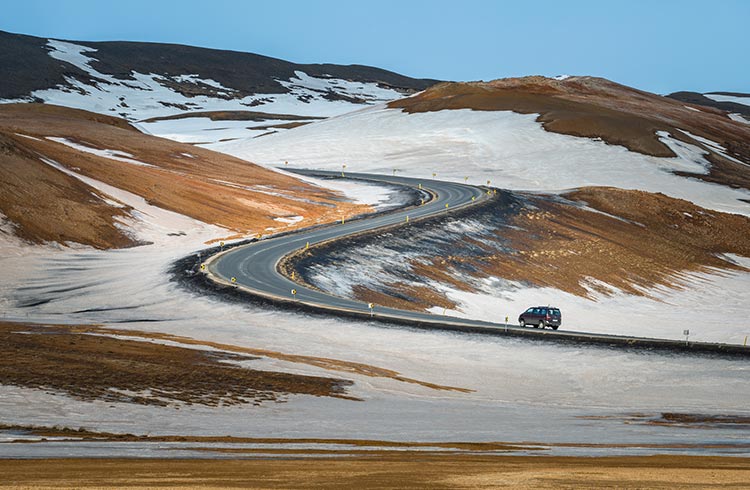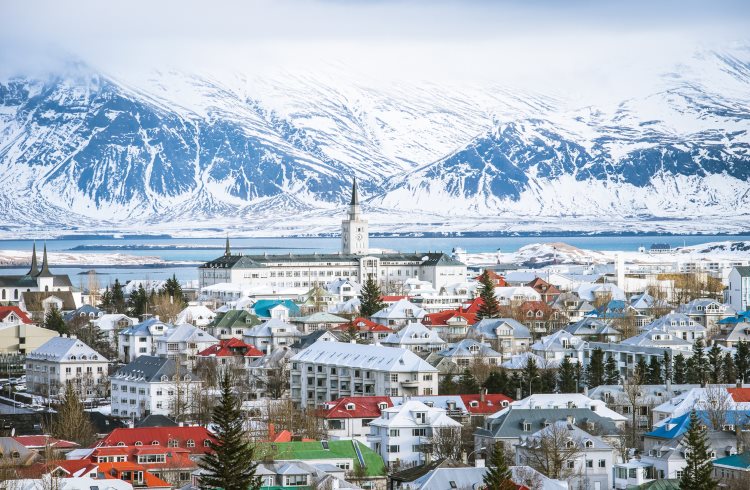Safety Tips for Travelers Driving in Iceland: Are the Roads Safe?
Most of Iceland's metro roads are amazing to drive on, it's when you get out of town that you really need to pay attention.
 Photo © Getty Images/Boy_Anupong
Photo © Getty Images/Boy_Anupong
Self driving around Iceland can be one of the best ways to see the country from the spectacular black sand beaches, to towering columnar basalt lined waterfalls and glacier capped volcanoes, it is well worth grabbing a rental car and hitting the road. Iceland also has some great towns and quaint villages to stop off at on the way.
In a country which has approximately 320,000 people, you would think it would be easy as jumping in the car and driving off for the trip of extraordinary proportions. But there are some things to keep in mind to ensure your journey is a smooth and safe one.
Basic road rules for Iceland
All drivers in lceland including tourists must have their headlights on at all times.
Speeds limits throughout Iceland are lower than in many other countries. The fastest you'll probably be able to go is 50 to 56 mph on paved highways. The speed limit for cities is typically 31 mph in and 30 km/h in residential areas. Some other driving laws in Iceland include no right turns on a red light; yielding to the driver on the right at four-way intersections; and giving way to drivers in the inside lane in roundabouts.
Seatbelts for all passengers, even those in the back seat, are required. Cell phones can not be used without a hands-free headset.
Driving under the influence of alcohol or drugs is strictly forbidden.
The glare in winter from the reflecting snow and low lying sun can be a mean SOB, so pack those sunnies!
Road conditions in Iceland
Iceland's road network is easy to navigate which makes it great for visitors who want to see Iceland on a self drive tour.
The Highway No. 1, known by the locals as Hringvegur or Ring Road and runs 900 miles around the entire country. It is open most of the year with the occasional temporary closure in winter or for repairs.
But some roads in Iceland are not as open and maintained as one might think. Barely a third of Iceland's total network of roads are paved - the remaining are gravel or dirt, especially those winding through the middle of the country. However the major highways including the national ring road are paved and some of the paved roads are very narrow and might not have shoulders to pull over on. So if you do decide to stop off to sightsee, make sure you pull over somewhere safe and out of the way of traffic.
Travelers who choose to rent cars to drive through Iceland should check their coverage level for certain types of roads, especially those in rural or unsecured mountain areas. Be aware, too, that renting a car there is expensive, especially for four-wheel drive vehicles, which are required if heading into the interior rugged parts of the country.
There is a network of roads mainly in the highlands of Iceland known as F-roads. Naturally, loose gravel poses a problem on these roadways, and you should slow down and heed the signs. If you want to use the F-Roads, you will need a 4x4 rental vehicle as all types of rental vehicles are not allowed. Generally, these roads are only open for the summer months.
Some of the signs you may see while driving include:
- Malbik Endar - indicates a change from a paved road to a gravel road
- Einbreið Brú - one lane bridge, most bridges in Iceland are one lane
- Illfær Vegur - any road which is inaccessible by car and 4WD only
- Blindhaed - blind rise or crest in the road, important you stay in your lane
- Slysasvaedi - accident prone area
- Lokad - closed
At certain times of the year, road travel will be more difficult, if not impossible. From early winter to mid-summer, some of the central roads cutting through the country may be marred by mud.
Some highland tracks may only be open for part of the summer, and you should always check with the Icelandic Road Administration, or Vegagerdin, before driving there or to other remote areas. Off-road driving is strictly forbidden. The damage done would take decades to repair itself.
Driving is also hazardous during the days of full darkness occurring between October through April, which is also the span when weather changes most rapidly. Snow tires are also required after October.
Travelers are advised to carry food and water in their cars and know where to find lodging in case they encounter road closures or severe weather. In rural areas, you often drive a long way before hitting the next town or even a gas station, which is usually open 24 hours.
Beware of speeding drivers on long stretches of road and farm animals like sheep that wander into your path. Sheep and horses will often graze wild and if startled, can run onto the road. Should you happen to hit a sheep or lamb, immediately notify the farmer or Logreglan (police). Farmers are generally insured for losses, so you need not flee the scene in fear of fine. It also assists in reducing the animal's suffering if injured.
The Icelandic Association of Search and Rescue have set up a website where travelers can register their trip in the event there is a natural disaster or need to be rescued should travelers not return by notified date. They also have a great app where travelers can check in or request emergency assistance.
There are also roads in Iceland that snake up cliffs and have few barriers. Be extremely cautious if navigating these twists and turns, as a false move can be deadly.
These can also include changes in river levels, which can make some areas completely impassable. It's no wonder Icelandic law requires all drivers to keep their headlights on at all times.
Fording rivers (crossing in the shallow part) can be exciting and fun, but make sure that you are totally confident that you can ford a river before doing so. Insurance will not cover damage to the car or rescue. When in doubt either find another road or wait for more experienced drivers to show you the way.
16 people died on Icelandic roads in 2015, a low amount by some estimations, but still a higher rate per capita than countries like England. However, as Iceland becomes a popular holiday destination and more people take to the roads, the risk increases. 223 tourists were injured in traffic related accidents in 2016.
And after all the temptation to stop in amazing places while driving doesn't grab you, it's possible to get around Iceland via several bus lines, planes or by bike. Hitchhiking is also still an acceptable and safe form of transportation in this country. The only real danger to it is that you might wait long periods of time between seeing cars, sometimes as long an hour.
Related articles
Simple and flexible travel insurance
You can buy at home or while traveling, and claim online from anywhere in the world. With 150+ adventure activities covered and 24/7 emergency assistance.
Get a quote
2 Comments
Excellent advice. There are a few more things one could add when it comes to driving in the highlands (F-roads). We compiled some info on the subject here:
http://www.rent.is/blog/driving-the-highlands-in-iceland
Safe travels!
Thanks for this helpful article.